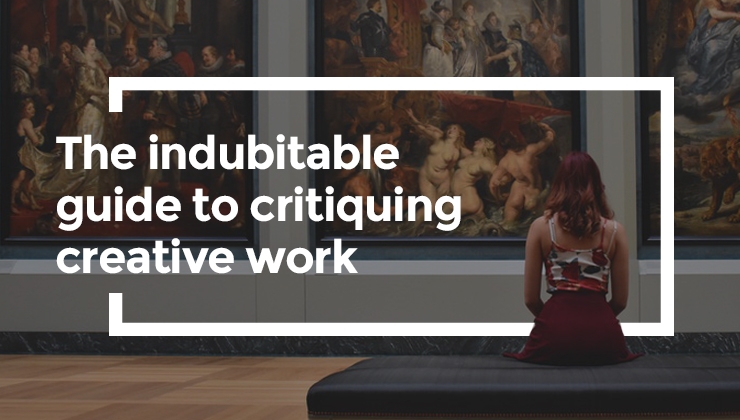
Random Simpsons GIFs added by free-thinking Copywriter. Compromise is imperative.
“If I might just suggest…”
“If you could be so kind…”
“Have you considered…”
“What if we just…”
Critiquing creative work is a deceptively complex process.
It’s a balancing act in people skills, marketing insight, and creative understanding.
It’s never as simple as ‘trusting your gut’ - you need to weigh it up against:
- What’s right for the audience?
- What’s right for the client?
- What has gone before?
- What is the competition doing?
In order to critique a piece of creative work successfully, I think there are seven key areas to consider. Remember; you’re assessing not judging. Nurturing, not destroying.
Indisputable step 1: Tackle the brief before you give it to your creative team
Critiquing starts before the creative department have even smelt the job come through the door.
The client briefing is the first stage for the account handler to offer value and expertise.
Think:
- What’s at the heart of the brief?
- Why are certain parts prescriptive and others not?
- How much room is there for negotiation?
- Is the brief disruptive compared to their previous efforts?
All of this context will produce a better standard of work. Ask questions early on and get the clearest picture possible.
Once this context has been established, it’s important for the Account Manager (AM) to distinguish what the core requirements are. A creative brief isn’t just interpreted by the creative team - AMs also play a key role in it being executed correctly.
Top Tip: For larger projects it can be worth sharing the finished creative brief with the client to get their sign-off on your interpretations.
Incontestable step 2: Give your creatives space to think
It’s easy to produce repetitive work in order to save costs.
If the work is always the same; why use an agency at all?
Sometimes you will have to accept that allowing your creatives time to experiment and research is worth it in the end.
You need to be proud of the work going out the door.
Let the idea breathe. It’s not just their name associated to that work - it’s yours too.
Top Tip: Facilitate time into your budget. As George Lois says “Think long, write short.”
Irrefutable step 3: Talk face to face with your creative team
The team have the brief and they’ve worked hard on their response.
They’re excited by their ideas, even if some may be slightly left field of the brief.
Creativity is such a personal thing, so it’s easy for people to take criticism personally. It’s their experiences and thought process laid bare after all.
Sending feedback in an email can come across as curt or rude. Tone is a fickle thing, and sometimes it’s hard to convey what you’re trying to say with nuance.
Talk to your team face to face. Particularly if the client is offering some harsh feedback. Don’t just forward the email.
It’s the AM’s job to communicate feedback in a constructive way.
Top Tip: Don’t send unfiltered feedback - the client might not know how to give feedback in a constructive manner.
Unequivocal step 4: When delivering ideas, don’t play it safe
An agency’s duty is to deliver something that disrupts, and as an Account Manager it’s your job to lead the creative process.
If your creative work is safe it will go unnoticed.
Appealing to all is often appealing to none.
Don’t be afraid to push the boundaries and deliver something the client wasn’t expecting.
The element of surprise can work in your favour.
You can still deliver on a brief and deliver something out of the ordinary.
If your creative team come back with something you consider to be white noise, then tell them - in a respectful way.
Top Tip: Deliver something unexpected that still hits the brief.
Undebatable step 5: Prioritise changes
Producing creative work is a collaborative process, which means mixed opinions are bound to surface.
To create the best work a compromise has to be reached on both sides. This is vital if you want to stay friends with your colleagues.
Draft a list of your changes and prioritise them.
Identify what is a ‘must-change’ and what is a minor suggestion.
By prioritising these changes you’re reducing stress and making the creative process less restrictive.
Top Tip: Figure out which changes are essential and feedback accordingly. Don’t just turn up with a huge list of amends. It kills the conversation around the work.
Emphatic step 6: Figure out if it’s actually achievable; talk to a developer
Obviously specific to digital projects, but make sure your creative can be built.
Always show a developer your plans before showing it to a client.
The idea you’ve come up with might not be achievable within the budget.
It might be too complex to execute.
There could be another way of doing it.
The user experience might be terrible on mobile.
Talk to your experts and find out if it’s doable.
Top Tip: Involve everyone who has to deliver the project so everyone has ownership from early on.
Conclusive step 7: Give respect to get it
Supporting your arguments with reason and logic is the best way to have your feedback respected.
Opinion without support is like style without substance; it comes across as unnecessary.
Your opinion does have a place in the feedback process, but it helps if it’s backed up with reasoned judgement.
Top Tip: Frame feedback as a discussion, rather than a firing squad.
Want our creative team to create a big idea for your next campaign? Talk to us.








